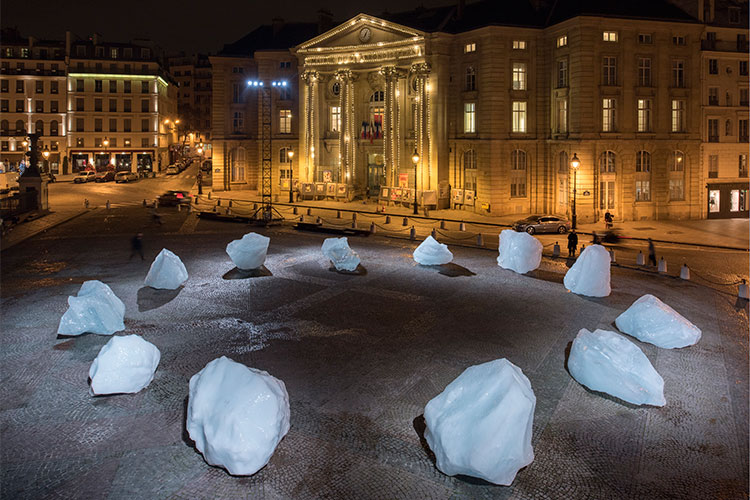Future conditional: Artists and designers at COP21
ArtCOP21, at the Paris climate talks, brought together artists and a plan: “To truly meet the climate challenge, we need to get creative.” Associate Vice Chancellor for the Arts and Design Shannon Jackson reports from the scene.

December 10, 2015
Shannon Jackson, UC Berkeley associate vice chancellor for the arts and design, is in Paris for the global climate talks and as an ArtCOP21 speaker. She sends this report:
As international leaders wrangled about how to address the effects of climate change in Paris, ArtCOP21 hosted exhibits, dialogues, interviews, and performances. Described as “a global festival of cultural activity on climate change,” ArtCOP21 brought together artists and a plan: “To truly meet the climate challenge, we need to get creative.”

“Ice Watch” at night (Photo by Martin Argyroglo)
The Nordic environmental artist, Olafur Eliasson, installed “Ice Watch” on the stone plaza in front of the Pantheon, assembling 12 large ice blocks in a clock-like circle. “Ice Watch” carried the sense of both observation and duration, providing visitors with an opportunity to confront the speed with which life on the planet is changing. While many artists used melting ice as a resonantly metaphoric material, the fact that Eliasson’s ice was sourced from the melting fjords of Greenland made his project all the more unsettling. The white chunks seemed almost sentient as they dissolved; like beached animals removed from their natural habitat, they died before us, provoking the uncanny wish that they could somehow be put back.
The artist Mel Chin, much beloved in circles of socially engaged art, appeared as well. Chin flew in Inuit collaborators from Greenland as well as the writer and filmmaker Gretel Ehrlich (author of “Rotten Ice: Traveling by dog sled in the melting Arctic”). Together he and NPR correspondent Neal Conan shared stories, photographs and films that exemplified the interdependence of two apparently independent regions. “Paris” and “the Arctic” sat next to each other in a poignant, if under-recognized, intimacy.

Selfie at ArtCOP: Shannon Jackson and Mel Chin
The extraordinary filmmaker, Charles Ferguson (a Berkeley alum) deployed a panoramic landscape in Time to Choose. Connecting the grand scales of planetary transition with individual volition on the ground, Ferguson made the full film available to the world as a free live stream.
Berkeley alumna Heidi Quantes and her collaborator, Alicia Escott, took another creative tack, installing a parody of environmental bureaucracy titled The Bureau of Linguistical Reality. Dressed in ranger garb, Quantes and Escott explore the language of environmental consciousness, inviting participants to invent new words to help isolate the complex processes that allow people to face or to ignore the spatial and durational scale of an eroding planet. “Blissonance,” for instance, mixes “bliss” and “dissonance” to describe moments when an “otherwise blissful experience is disrupted by the recognition that one is having an adverse impact on the place” one enjoys. “Pre-traumatic stress disorder” describes the condition of someone who anticipates a dystopian future while observing a “world around them not making necessary precautions.”

Heidi Quantas and Alicia Escott and their “Bureau of Linguistical Reality” (Photo by Shannon Jackson)
As summit leaders convened in a city that endured terrorist attacks only three weeks earlier, artists found new ways to dramatize the stakes for varied members of the world’s population. New security measures meant that Parisians couldn’t use a familiar performance form — the street protest — to share their views. However, the French artist JR and the film-maker Darren Aronofsky de-familiarized that form to stunning effect in “The Standing March,” projecting hundreds of faces and bodies from around the world and using the iconic building of the Assemblée Nationale as a three-dimensional screen. This march was all the more effective for having been arrested, stalling and installing this mass of bodies so that they can watch and be watched simultaneously.
Writer and Berkeley alum Rebecca Solnit described Aronofsky’s work and other events as a “day of phantoms,” where the phantoms of 130 killed on Nov. 13 mingled with the phantoms of those forbidden to march in the weeks after.
Of course, the most potent symbol of artistic protest came about in an action without artistic signature. On Nov. 29, 10,000 pairs of empty shoes appeared as site-specific installation where the bodies of protesters might have been. They served — and still serve — as a visceral reminder of bodies taken and of the bodies that remain.
Creative activation provokes reflections that are intimate and gigantic, poignant and ironic, all toward activating a new consciousness of the future conditional.
Read more on the Berkeley Arts Research Center’s Arts+Design blog
Read a Q&A with Shannon Jackson about her vision for UC Berkeley as an “arts research lab and arts engine.”
View all of Berkeley News‘ climate conference coverage.